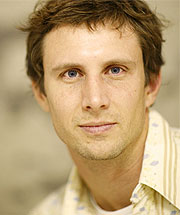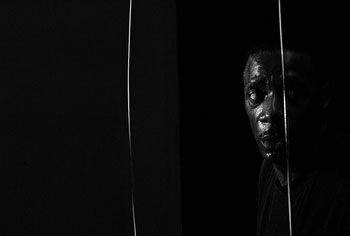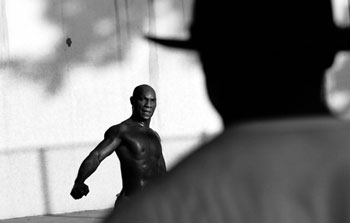 |
→ October 2006 Contents → Column
|
At Home with David Alan Harvey - Workshop 2006:
A Week of Inspiration and Learning October 2006
|
 |
|||||||||||||||
|
"Authorship, authorship, authorship" was the mantra set forth by David Alan Harvey on day one of what was about to be an incredible week of photography. From September 16th to the 25th, I was lucky enough to be one of eight 'hand-picked' photographers taking part in a unique workshop created by Harvey.
I met David just under two years ago at a workshop in Mexico that he and Kent Kobersteen taught through National Geographic workshops. That workshop went right for me and I got to know David and Kent well enough to periodically keep in touch.
Fast forward to July 2006: I sent David my semi-annual e-mail just to touch base and see how his projects are coming along. I got a response from Marie Arago, his assistant, spelling out a unique workshop they were putting together to be held at David's loft in New York. As David put it, this workshop would be "for the strong only looking to get stronger," and filled with "jam sessions" with friends of his in the industry, ranging from editors to well-known photographers. David e-mailed me the next day letting me know that there was one spot left and it was mine if I wanted it.
Holy Shit. Okay.
Here's a touch of background to put the "Holy Shit" into perspective: Basically, I'm a 33-year-old passionate photographer (obsessed, really) who is dying to take the leap from my income-earning job as an engineer to photographer and still pay the bills. This isn't anything new. For several years now I've been designing my life to make this transition, such as working only on a contract basis to keep my freedom of schedule, and shooting personal projects; but I have yet to fully make the leap (frankly that's another discussion altogether).
And in classic Harvey style, he expressed with a grin, "We really don't know what's going to happen this week."
We met Saturday morning in Robert Clark's studio across the hall from David's loft. This was to be our home base for the week, located in the infamous "Kibbutz" as it's known in some circles. (The building's rich patina and location over the water in Williamsburg was also part of the inspiration and experience.) David opened the floodgate with a buzz-session on the importance of authorship, point of view, independence, essays vs. stories, moving beyond the didactic and into the esoteric, and a wonderful heap of David Alan Harvey-isms that had my head swimming but definitely looking forward to the rest of the week.
Creating a project to shoot in New York City sounded easy until I walked out onto the street and experienced near sensory overload. I had to narrow it down. I ended up shooting a photo essay on the grace of street athletes. This was a concept that I stumbled onto after shooting some random stills of a handball game on Sunday afternoon. David liked how I captured the movement of the players and we decided to take it from there. This was a departure from what I had in mind before the trip, which was more like an intimate or hard-hitting Eugene Richards-type story. But really I only had a week and I had to move on an idea pronto.
Like any project, there were days of success and days of frustration. Sometimes the street athletes I met were very open and that's when the magic happened. At other times they clearly didn't want a camera around, or didn't show up when we had planned to meet.
"Authorship... show my unique vision... the ballet of street athletes..." At times I found myself pacing and repeating this to myself like a madman, putting the pressure on to find just the right group of guys playing on a court in just the right light, and to photograph them in an artful and unique way. I felt like I was interviewing for a position at Magnum. But I'm also one who has no problem laughing at myself to bring it back down to earth. It just has to happen naturally. You get in the zone when you relax. I know this. I've done this before.
What spoke to me? What did I HAVE to show from what I saw and felt? In order to achieve authorship, I had to answer these questions. It was the forceful and balletic movements of the handball players, the emotional chatter and shit talking, the whirls of jump ropes in the gym, the rhythm of fists on the speed bag, smell of sweat and hard work that emanated from the chipped-paint walls and floors of the gym. The grace of the athletes that made these places what they were, that is what I set out to capture.
Saturday - Eugene Richards Sunday - Nick Nichols Monday - David Griffin Tuesday - Brenda Ann Kenneally Wednesday - Susan Welchman Thursday - Mark Lubell, Brian Storm Friday - Medford Taylor and Laura el-Tantawy Saturday - MaryAnne Golon, Christopher Anderson, Kadir van Lohuizen
These jam sessions ranged in substance from how the photographers approach his/her projects, what editors are looking for, the importance of authorship, sketches of their career journeys, and viewpoints on where the industry is headed.
There are, however, examples of success such as Ed Kashi's and Julie Winokur's production of their multimedia story, "Aging in America." Projects such as this, created and distributed through avenues like MediaStorm.org, are likely going to be the look of the future.
9 p.m.: Everyone inside, doors locked, the room was packed. This was a classic gathering of photographers who share the passion, sitting Indian-style on a hard tile floor, looking forward to the shows on deck.
First up, David introduced his longtime friend James Nachtwey. Everyone knows James's special place in photography's history. I've seen him speak and give slideshows before, but in this packed little studio in New York, this felt more intimate. "We're all here to have a good time. But these pictures are not about having a good time." Jim said in his steady and calm voice. Jim's witness to world atrocities cannot be taken lightly even in a party atmosphere like this. The slideshow began and the room was quickly transported into some of the darkest corners of the world where human suffering prevails. His pictures give voice to those suffering from war, genocide, and AIDS. The photographs were beautifully hard-hitting. My heart was on the floor and my eyes wet with tears. I think that sentiment filled the room.
Jim's photographs speak firmly on their own, but to me there was an added element to the images with him in the room while the frames passed. Perhaps it was imagining being with him and coming back home to carry on some semblance of a 'normal' social life, especially at a party like this. It was all very effectual.
Next, Jim introduced his former assistant and powerful documentarian, Samantha Appleton. I had seen her work before but had never put a face behind her images. Her images from Iraq are some of the best I've seen. To keep this impressive show rolling, Samantha gave a fun and personal introduction to Chris Anderson, whose work from Lebanon I had recently become familiar with. Chris showed an incredible work in progress from South America focusing on the changing political climate and rise of socialism in Venezuela and Bolivia. It was the perfect example of pushing yourself into large-scale personal projects. After a short break, we resumed (I think with even more people in the room) with Ed Kashi presenting "Three," an artful series of triptychs that connects unique selections taken from his 25 years of photographs from around the world. What a visual feast!
So how in the world were we supposed to follow four of the world's finest photographers at a group slideshow like this? Well you just go through the motions. David stood up and gave a quick sketch of what this workshop was all about followed by a warm introduction for the eight of us, and then our show began. The crowded room gave cheers and applause after each photographer's piece ran. It was a hit.
For me it really was a satisfying rush, bordering on overwhelming. In some small way it was like being accepted for a brief moment as a peer in this room full of heavy-hitters.
Not to be deluded, I know that I have a long way to go and the only way to get there is with hard work and commitment. And I have to take good pictures. As David tells me, "Remember, NO LIMITS!"
The inspiration came in many forms and from many sources. It came from David, the other working photographers and editors that I met, New York City itself, and of course my new friends and amazing talents with whom I shared these experiences: Erin Wigger, Veronika Lukasova, Casey Templeton, Benjamin Krain, Mike Berube, Jacob Pritchard, and Giulio Rimondi. David, Marie, and Denise, if you're reading this, thank you for a great week! Hasta Pronto!
© Lance Rosenfield
|
||||||||||||||||
Back to October 2006 Contents
|
|




